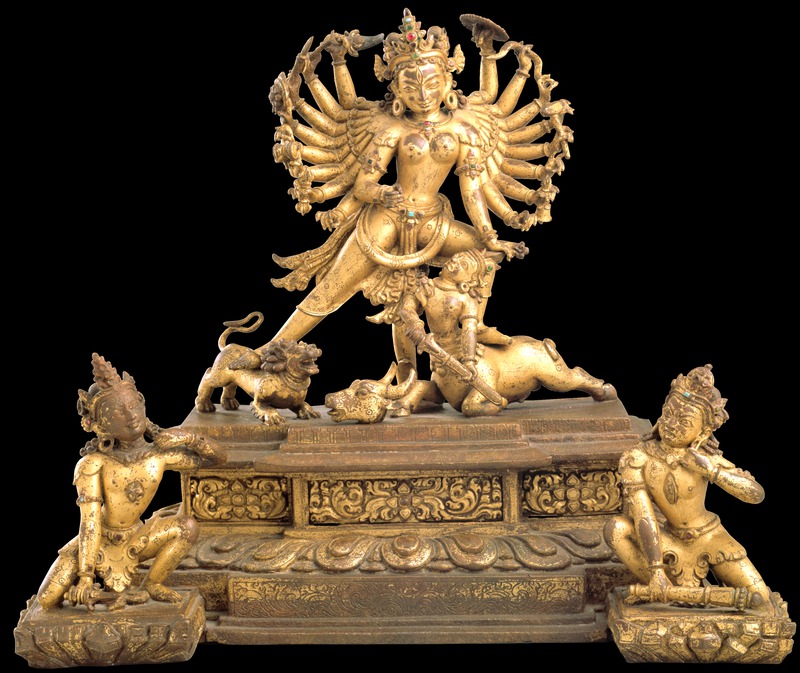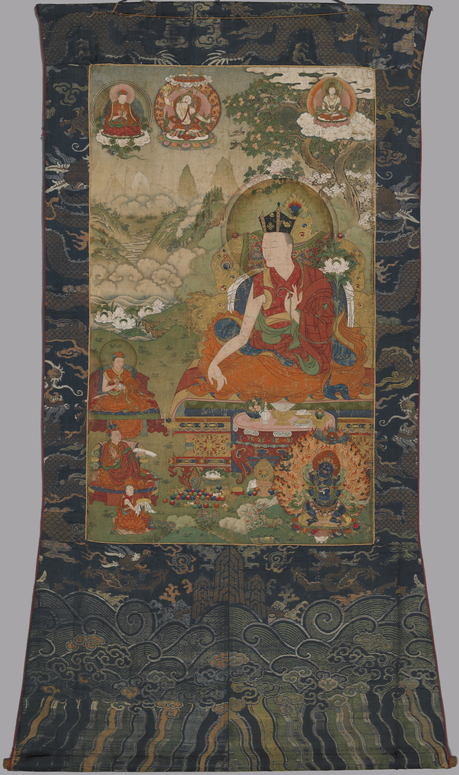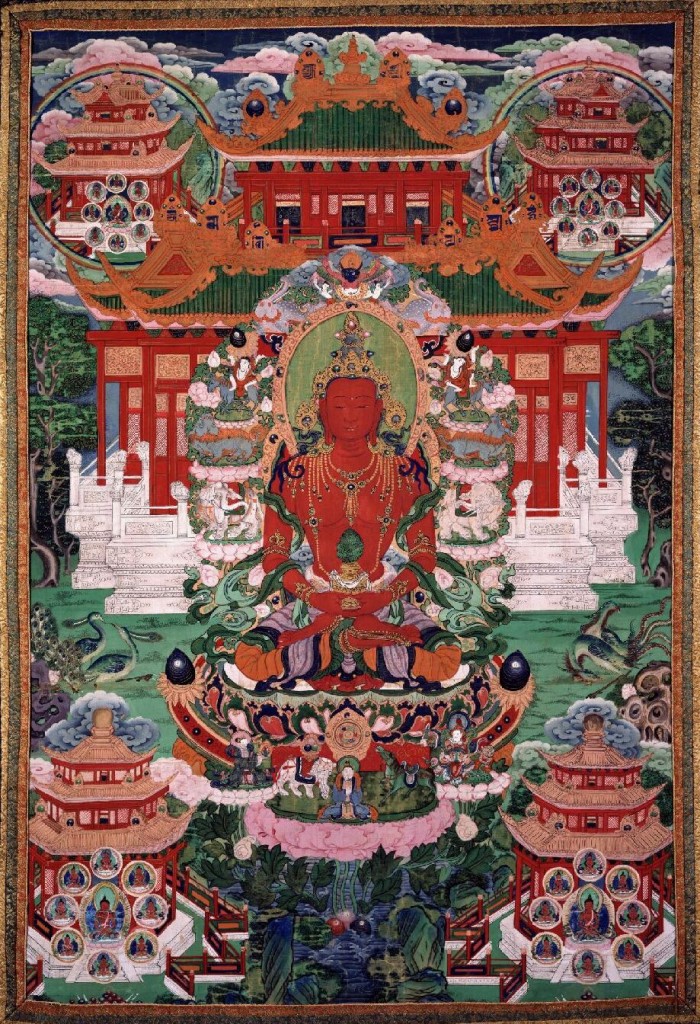February 1, 2012–September 24, 2012
Educator Resource Guide
How To Use This Resource
Durga
Thirteenth Karmapa
Buddha Amitayus
Glossary
Resources
Download this Guide (PDF)
How To Use This Resource
Masterworks: Jewels of the Collection displays some of the museum’s most stunning works of art. The stylistic diversity and relationships between various strands of Himalayan artistic traditions and neighboring cultures are represented by important works of art spanning a period of over one thousand years.
The contents of this Educator Resource are designed to be used by educators and students and can be adapted to suit the needs of a wide range of classrooms. Included are three key images from the exhibition. The guiding questions provided with each image are intended to draw attention to details in each painting and to the broad themes of the exhibition. It is always helpful to begin looking at each work of art with some basic, open-ended questions that will elicit observations and questions.
- What’s going on in this painting?
- What about this painting made you say that?
- Where else have you seen something like this?
We encourage you to use this guide in any way that works best for you:
- Learn about the exhibition as you prepare to bring your students to the Rubin Museum.
- Introduce art from the Himalayas and the main theme of the exhibition to your students.
- Use the guiding questions as a starting point for students to conduct independent research.
- Explore the additional resources to learn more about art from the Himalayas.

Durga Killing the Buffalo Demon
Nepal; 13th century; Gilt copper alloy; HAR 65433
Style
This outstanding sculpture perfectly combines the dynamic with the static. The goddess’s powerful stance and fan of arms are balanced by her otherwise delicate features and calm expression. The dramatic action of Durga killing her demigod opponents is frozen at its most crucial moment. The use of gilded bronze as well as the style of the deity’s large hoop earrings and patterned wrapped skirt (dhoti) are characteristically Nepalese. Unusual are the double knot of the goddess’s hair and the leaf-shaped shoulder covers she and her kneeling opponents wear.
Content
The narrative of the goddess Durga—her assembling the weapons of all the gods and overcoming the demigod Mahisha, who endangered the order of the world—is represented here by the moment the goddess takes absolute control of her opponents. Her stance weighing on the back of a beheaded buffalo, Durga stabs the body of the demigod emerging from the animal before he can even draw his sword. His two companions kneeling before her in agony have a vajra and a disk stuck in their chests. The goddess’s sixteen arms fan out, showing her arsenal of weapons, and the lion under her right leg is her animal companion (vahana).
Guiding Questions
- What do you notice about how the central figure is represented? Focus on pose, facial expression, and movement.
- This 3-dimensional work of art tells a story. Who are the characters and what might their relationship be?
- This sculpture is made of metal, gilded, and set with precious stones. Why might these materials have been used?

Thirteenth Karmapa, Dudul Dorje (1733–1797)
Palpung Monastery, Eastern Tibet (Karma-Kagyu School); late 18th century; Pigments on cloth; Purchased from the Collection of Navin Kumar, New York; HAR 65494
Style
An elaborate and heavy throne dominates this painting and emphasizes the teacher sitting upon it. The throne is set in a landscape that opens toward a river valley with shrubs, coniferous trees, and high mountains far in the background, as is characteristic of actual landscapes in some areas of Kham Province, Tibet. Above the main teacher is a crooked tree which both blossoms and bears fruit, an auspicious element derived from Chinese painting. The pastel-colored landscape contrasts with the colorful figures placed in it as if they were miraculous appearances.
Content
This is the last painting of a set of thirty-three thangkas from the Karma Kagyu School is dedicated to the Thirteenth Karmapa, Dudul Dorje (1733–1797). Above are his teachers, the Seventh Drukchen, Kargyu Trinle Shingta (1718–1766), the goddess Sitatapatra and White Amitayus, both long life deities. Opposite the Karmapa are his contemporaries Kagyu Trinle Namgyel (1740–1798), an unidentified Nyingma School teacher, and a portrait of the artist Karma Tashi of Karsho in eastern Tibet, who is offering a universe. The protector in the bottom-left corner is Mahakala Panjaranatha.
Guiding Questions
- What do you notice about how the bodies of these figures are represented? Focus on placement, size, gesture, expression and clothing.
- This Tibetan work of art is strongly influenced by the tradition of Chinese landscape painting. What roles do you think the landscape plays in this painting?
- This scroll painting (thankga) is painted on cotton and attached to a blue embroidered frame. How do the painting and its frame relate to one another? How do you think this thankga was originally used?

Buddha Amitayus in His Pure Land
China (Inner Mongolia); 19th century; Pigments on cloth; HAR 65037
Style
This painting is a fine example of the cross-fertilization of Tibetan Buddhism and Chinese aesthetics. Buddha Amitayus is shown seated on a lotus in front of an elegant Chinese palace. The Imperial architectural style has been closely observed—lion heads carved on posts, white marble balustrades, and roofs with upturned corners—suggesting that the artist was familiar with Chinese-style buildings. The shapes of the palaces at the four corners of the composition are common in later imperial garden settings. The arrangement of these surrounding palaces creates a sense of perspective.
Content
In the center of this composition sits Buddha Amitayus, the Buddha of Infinite Life, on a Chinese-style seat. In front of him a lotus blossom and its branches carry a king and his auspicious “Seven Jewels.” Amitayus presides over a paradisal realm with a two-storied palace behind him, the roof tiles of which carry the six-syllable mantra of Avalokiteshvara. The palaces in the corners of the painting represent realms similar to the central one and are situated at the cardinal directions around it, each of them occupied by an eight-deity assembly of the mandala of Amitayus.
Guiding Questions
- How does the pose and expression of the central figure reflect the space around him?
- The red buildings with tiered roofs reflect Imperial Chinese architectural styles. Why might these details have been included in the painting?
- This is an image of a beautiful paradise called a Pure Land. What details illustrate this? What details would you include in your own paradise?
Glossary
Balustrade: A rail and the row of posts that support it, as along the front of a structure.
Buddha: a title given to one who has attained spiritual awakening (enlightenment) in the Buddhist tradition. The term “the Buddha” often refers to Buddha Shakyamuni, Siddartha Gautana, who lived from approximately 563-483 BCE.
Buddhism: a religion and a philosophy that is based on the teachings of the historical Buddha, Shakyamuni Buddha. The Buddhist tradition focuses on the attainment of the enlightenment and nirvana and release from an endless cycle of death and rebirth.
Deity: the state of being divine; god or goddess.
Embroidered: decorated with ornamental needlework.
Figure: a representation in painting or sculpture, especially of the human form.
Gilded: covered thinly with gold leaf or gold paint.
Hinduism: Often described as a religion of millions of Gods, Hinduism is a conglomeration of religious, philosophical, and cultural ideas and practices that originated in India, characterized by the belief in reincarnation, one absolute being of multiple manifestations, and the desire for liberation from the cycle of births and deaths.
Karmapa: the head of the Kagyupa, Karma Kagyu of Tibetan Buddhism.
Pure Land: a Buddhist paradise, ruled over by the Buddha Amitayus, in which many deities are believed to reside.
Three-Dimensional: having the dimension of depth along with width and height.
Resources
Web Resources
Masterworks: Jewels of the Collection
www.rmanyc.org/masterworks
Explore exhibition resources to further explore the museum’s jewels from the Himalayas.
Rubin Museum of Art
www.rmanyc.org/education
Explore multimedia resources and videos. Find out about current and upcoming exhibition and programs at the Rubin Museum of Art.
School Programs: Rubin Museum of Art
www.rmanyc.org/schoolprograms
Browse and learn about the different programs the museum has to offer for students K–12.
Universities: Rubin Museum of Art
www.rmanyc.org/universities
Learn how you can use the museum, our collections, and online resources as an extension of the classroom.
Himalayan Art Resources
www.himalayanart.org
Search a virtual museum of documented Himalayan art that includes high-resolution images, essays, articles, thematic collections, bibliographies, and activities for children.
Treasury of Lives: Biographies of Himalayan Buddhist Masters
www.tibetanlineages.org
Browse biographies and portraits of Tibetan Buddhist and Bon masters by religious tradition, geography, community, and historic period.
Educational Interactive Library
http://interactive.rma2.org/
Journey behind works of Himalayan art on this interactive site, revealing the stories, ideas and beliefs that inspired them.
Reading List
- Beers, Robert. The Handbook of Tibetan Buddhist Symbols. Boston: Shambhala Publications, Inc., 2003
- McArthur, Meher. Reading Buddhist Art: an Illustrated Guide to Buddhist Signs and Symbols. London: Thames & Hudson Ltd, 2002
- Leidy, Denise Patry. The Art of Buddhism: An Introduction to its History and Meaning. Boston: Shambhala Publications, Inc., 2008
- Menzies, Jackie, ed. Buddha: Radiant Awakening. Sydney: Art Gallery of New South Wales, 2001


